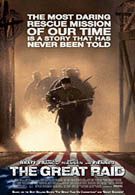Some of my favorite movies are the Great War flicks of the 1960’s. The Bridge Over the River Kwai, The Great Escape and The Longest Day stand out in my mind, stories that captured the heroism and determination of those who served and died. In recent years Hollywood has taken the World War II film genre to a heavier level with graphic realism and heightened emotion. Band of Brothers and Saving Private Ryan are great films, but there’s something classic about the storytelling style of the war films of the ‘60s. The Great Raid echoes that style with a true but rarely told story about one of the war’s boldest rescue missions.
The infamous Bataan Death March of World War II occurred when 70,000 American and Filipino troops were stranded from naval support by the same crushing Japanese attacks that just days before had devastated Pearl Harbor. Eventually forced to surrender, 12,000 of the famished and weakened troops were mercilessly force marched over 55 miles to prisoner camps, a march that resulted in the deaths of over a thousand soldiers. Those who survived the cruel and deadly event faced harsh conditions and malicious captors. For three years the men of those camps would wait and suffer, their only support coming from underground resistance cells which secretly provided badly needed medicine and messages of hope.
When the tide of the war in the Pacific changed in 1945, Allied troops returned and began liberating the Philippine Islands. Rather than face the disgrace of their prisoners of war being rescued, Japanese forces began “liquidating” the soldiers, often by burning them alive. The United States 6th Ranger Battalion, a group of highly trained men who had yet to see combat, were given the task of infiltrating a POW camp at Cabanatuan and rescuing its more than 500 American prisoners. Led by Lt. Col. Henri Mucci they would handle what many considered to be an impossible task.
The Great Raid, based on the books “The Great Raid On Cabanatuan” and “Ghost Soldiers”, follows three closely knit stories set amongst the true events surrounding one of the Bataan prisoner camps. Each moving storyline presents a different front of the war: the POW camp, the Allied liberation effort and the Manila underground. The three are woven masterfully together, merging in bittersweet ending that would seem to honor all POWs, those rescued as well as those left behind but never forgotten.
Everything about this film resounds with excellence. A gritty, desaturated visual style and rousing (if not slightly melodramatic) score set the tone. The plot isn’t smothered by unnecessary moral diatribes. Characters aren’t burdened with heavy monologues about the evils or necessities of war. The situations, based on true events, speak for themselves and director John Dahl keeps the film’s pace moving without caving to dramatic sensationalism. As if to remind the audience just how true the story is, the opening and closing of the film consist of actual footage related to the real life military operation. The movie’s finale is a moving blend of fact and fiction that left everyone in the audience sitting in reflective silence as the credits began to drift onto the screen.
The cast is by and large perfect, reviving an all but forgotten style of war-storytelling. Once again the Academy Awards have failed by not providing for a best ensemble cast category. The established screen presences of Joseph Fiennes and Connie Nielsen are flawless as the leader of the prisoners at Cabanatuan and the woman who is leading the underground effort to keep them alive. Martin Csokas, known to most as Celeborn from Lord of the Rings absolutely steals the show as Fiennes’ right hand man. He practically channels Steve McQueen, capturing the essence of the classic WWII film.
Benjamin Bratt and James Franco, who play the commanding officers of the 6th Ranger Battalion, each turn in performances a grade above what we’ve seen from them in the past. For their sakes it’s a shame that this film, originally completed and ready for release two years ago, was held back so long (you can thank the Miramax/Disney debacle for the delay). Bratt might have been spared the indignity of appearing in Catwoman and Franco might be recognized for more than just his Spider-Man roles. Hopefully both will receive some due credit for their simple perfection in The Great Raid
The producers of the movie had been battling to get the film’s rating reduced from R to PG-13. I can understand why. I’m sure money plays a major role, but I’d like to think they have a bigger picture in mind. I’d like to think they feel, as I do, that this is a movie teenagers in high school should be able to see. The film doesn’t achieve the brutal goriness of Saving Private Ryan but it doesn’t shy away from showing the horrible atrocities of war either. It earns its R rating and it should bear that badge proudly. Nevertheless, parents shouldn’t hesitate to take their teens to see this film. It deftly demonstrates the heroism and courage of those who lived and died during the war and acknowledges that the battles were rarely fought by Americans alone. People of many nations and backgrounds fought and died together to defend each other and conquer common threats.
It’s been awhile since a movie recaptured the exhilaration of a good, classic World War II hero story. This one fulfills that and more, balancing action and drama, firmly holding the viewer’s attention while presenting a stirring piece of history. Many desensitized audiences may find it lacking, since most war movies these days lend themselves to overdrawn emotion, copious severed limbs, and massive body counts. It’s their loss. The Great Raid is a wonderful tribute and an excellent film.
Most Popular




